Whether you have pet pigeons or not, sometimes there are instances when you might need to trap them.
Perhaps you are trying to corral your own pet birds or perhaps there are some wild pigeons that are bothering your pets.
In either case, you likely don’t want to harm the birds, but instead want to catch them and get them to a new safe place without a lot of hassle or stress.
That’s when having a good pigeon trap comes in handy.
In a rush? We recommend these traps:
As an Amazon Associate I earn a small fee from qualifying purchases made through Amazon links. This helps us run the site – thanks for your support!
- Bird B Gone Pigeon Trap
- Tomahawk Double Door Rigid Pigeon Trap
- Humane Snap Trap
- Nixalite Rooftop Pigeon Trap
- Bird Barrier Pigeon Trap
Being prepared with a trap that you can pull out when needed makes it infinitely easier to keep your own pet birds safe as well as safely relocate feral pigeons who are encroaching on your space.
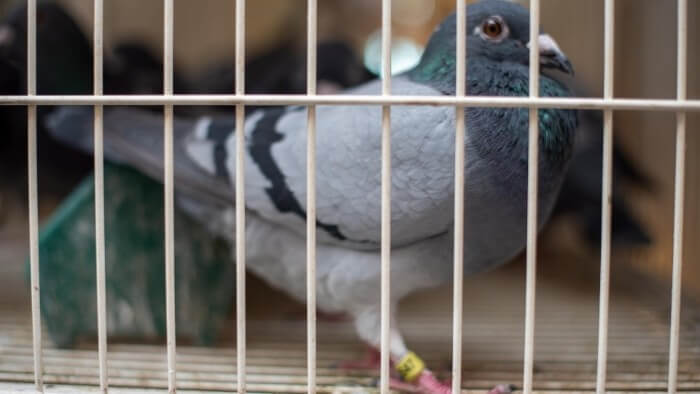
The Best Pigeon Traps
Now that you know how to choose and use your pigeon traps, it’s time to make the selection that makes the most sense for you.
Don’t just choose the first one that comes along. Take some time to evaluate your options and then make a decision.
Below are some of the best pigeon traps available:
1. Bird*B*Gone Pigeon Trap

If you’re looking for an ultra-humane way to trap pigeons, this is the trap you’ve been looking for.
The Bird*B*Gone Trap features three one-way doors so the birds can get in, but then they can’t get back out.
There’s also a center hatch on top of the trap so that you can easily remove the birds when the time comes.
The hinged shade screen allows you to provide a shady place for the pigeons and there’s also a water and food container so your pigeons won’t get hungry or thirsty before you’re ready to remove them from the trap.
The lightweight design of this trap makes it easy to move around as needed and it’s easy to store when not in use.
The trap holds at least 12 pigeons so it works great in places with large numbers of pigeons.
2. Tomahawk Double Door Rigid Pigeon Trap

The best feature of the Tomahawk Double Door Rigid Pigeon Trap is the double doors, which allow you to bait the birds into the trap from both sides. This is handy for larger spaces where there are more birds.
The trap is designed so that the bird can get inside, but then has a difficult time backing out so they remain inside.
If you choose our collapsible model, you can also save space when you store the trap.
The trap is simple to set up and can hold several birds at one time, making it ideal for placing in areas where pigeons tend to congregate.
The materials are durable and won’t harm the pigeons, but smaller birds may be able to escape through the bars so keep that in mind.
3. Humane Snap Trap

This trap is designed for bird hunting but is a good choice for keeping on hand at home for catching pesky feral pigeons when they come around.
The reason this trap works is because it doesn’t feature the wire covering that most others do.
That gives pigeons more of a sense of openness, making it easier to get them inside the trap.
Once inside, the trap’s spring is released and the netting comes down over the bird, capturing them inside. All you have to do to get the pigeons into the trap is to bait the mechanism that hangs at the opening and then wait.
This trap only works for one bird at a time and smaller pigeons may be able to escape so keep that in mind if you choose this one.
4. Nixalite Rooftop Pigeon Trap
View it here.
The reason this trap makes the list is that it’s ideal for use on the roof, which is where many groups of pigeons can be found.
It works on both flat and sloped surfaces and has adjustable legs so you can stabilize it on many rooftops.
It also features six one way doors so the pigeons won’t be able to get back out once they’re inside the trap.
There are two access doors on top of the cage so you can remove the pigeons when you’re ready and there’s also a place for food and water inside, making this a humane way to trap pesky birds.
Also Read:
Pigeon Lofts For Sale UK
5. Bird Barrier Pigeon Trap
View it here.
If you’re looking for simple, this is the trap for you. It features a collapsible design that makes it easy to store when you’re not using it and just as easy to set it up when you need it.
There are doors on either end of the trap that pigeons will use to enter and the option to keep food and water inside for the birds. A spring-loaded door on top of the trap makes it easy to get the pigeons out.
You can add a variety of accessories to this pigeon trap, including a shaded cover and perches that can be used inside the trap.
This is an ideal choice for trapping pigeons on the ground.
Purpose of Bird Traps
The top reason to arm yourself with bird traps is that they are a humane way to catch pigeons, whether they’re pets or wild ones.
Most pigeon traps are designed to capture the pigeon without hurting or killing it.
If you’re using the trap correctly, you should be able to remove and relocate the pigeons without harming them in any way.
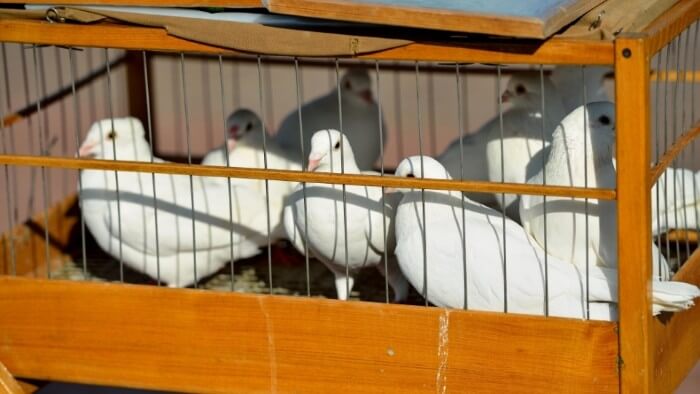
How to Choose a Pigeon Trap
There are many types of pigeon traps on the market, which can sometimes make it difficult to determine which one is best for your needs.
The biggest issue that people face when using a pigeon trap is getting the pigeons into it in the first place.
For that reason, it’s vital to find a pigeon trap that’s going to be effective.
One important thing to keep in mind is that pigeons enjoy having sky over their head when they forage and feed.
They are not drawn to areas where something over their heads will prevent a getaway if it becomes necessary.
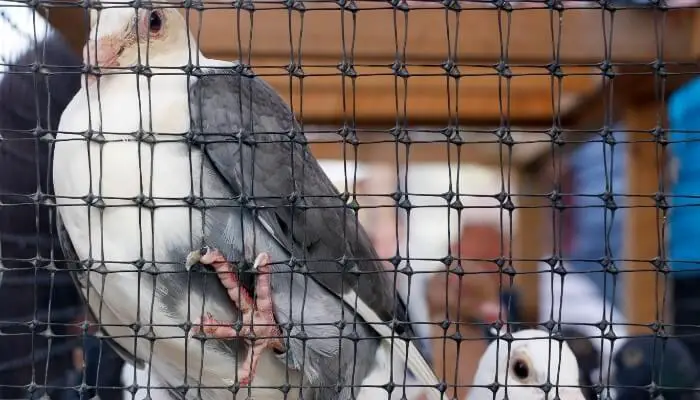
Most pigeons will avoid traps that have nesting material or anything else that makes it appear they can’t fly away if they want to.
So, the bottom line is that you want to find a pigeon trap that lets the pigeon feel safe as you work to capture it.
Another thing to be sure you are on the lookout for is a trap made with quality materials.
This ensures that the trap lasts for many years and can be reused to capture pigeons anytime the need arises.
Examine the trap and make sure it’s durable and can withstand repeated use.
That way you aren’t replacing it more than is necessary.
Getting a Pigeon Into the Trap
Once you’ve chosen a trap, the tricky part is getting the pigeon into it. After all, if you can’t capture the pigeon there’s no point to the trap.
According to bird experts, the secret to getting the pigeon into the trap is to get it to trust you.
To begin this process, you will need to wire the trap doors open.
This allows the pigeons to go into and out of the trap without worrying that they will be caught.
The next thing you need to do is to bait the trap every single day. You don’t need to be sneaky about this process.
Let the pigeons see you baiting the trap. It may take a few days or even longer, but eventually the pigeons should get curious enough about the bait that they venture into the trap to check it out.
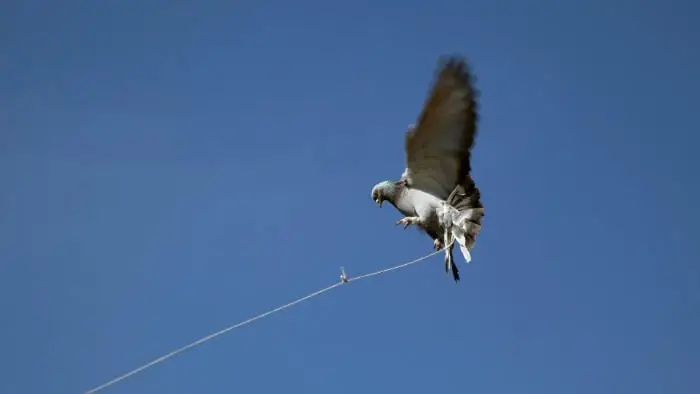
Once one of the pigeons discovers that the traps are safe, the others will likely follow suit.
The best piece of advice to keep in mind while you’re gaining the pigeon’s trust is to be patient.
It could take a bit of time before the pigeons do what you want them to do. Rushing the process won’t help and could even make it take longer.
Staying patient is the key to making your traps work for your purposes.
Baiting the Trap
Properly baiting your pigeon traps is key to ensuring that they do the job you want them to do.
The best thing to use as bait is birdseed since pigeons love it and will be motivated to forage it from the inside of the trap.
Spread about a ½ cup of seed around the inside of the trap so that the pigeons are encouraged to enter and scratch around for the bait.
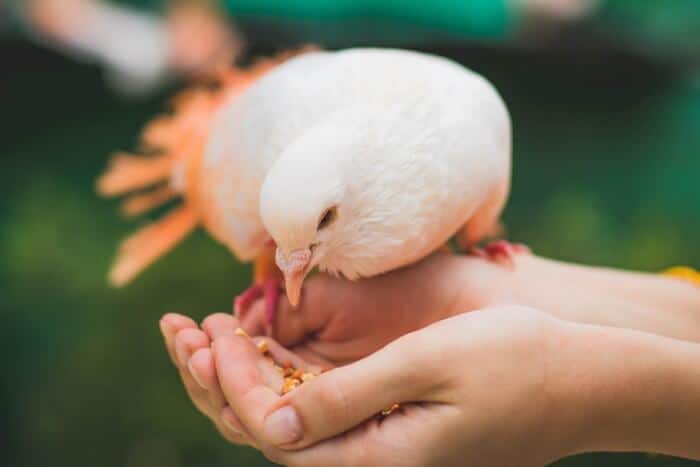
If you’re working to trap feral pigeons, watch their eating habits for a few days prior to baiting the trap.
You might notice that they enjoy eating the fruit from nearby trees or nuts from the trees in the area.
You can then use similar items to bait the trap. This will be enticing to them since it’s the food items they are already used to eating.
You can even collect these fruits and nuts if you’re able to and use them as bait that you won’t have to buy.
Make sure that the food you’re using to bait the traps is only available inside the trap itself.
If the pigeons can find the same things scattered around the trap, chances are they won’t ever venture inside.
Scout the area around the trap daily and check to be sure it’s clear of food so that the pigeons are encouraged to get inside the trap.
What to do with Trapped Pigeons
Now that you’ve trapped the pigeons, you’re probably wondering what to do with them.
It’s important to remember that pigeons are homing birds so they are likely to return if you simply relocate them.
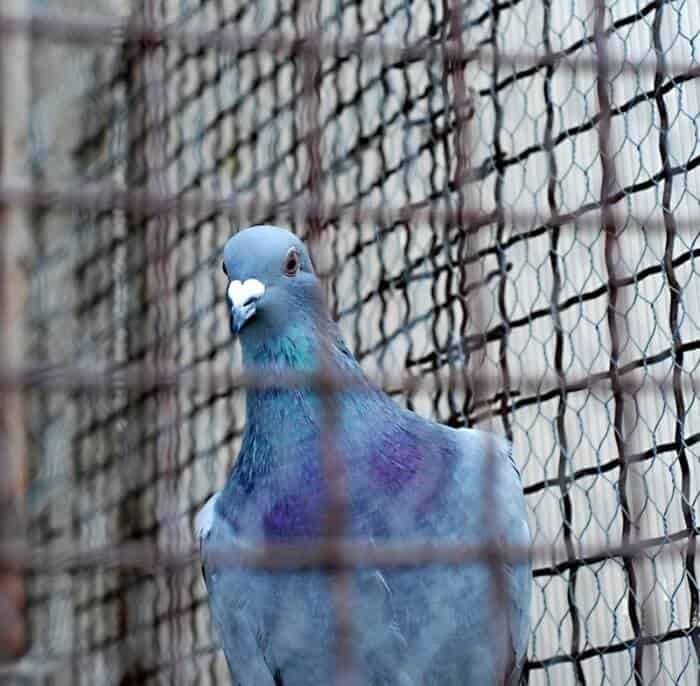
Many experts say the only way to keep them away from the area is to kill them.
If you don’t want to harm the pigeons, but don’t want to keep them as pets, talk to your local animal control agency about how to remove the pigeons for good.
However, don’t be surprised if some of them come back and you have to work to capture them all over again.
Other Ways to Get Rid of Pigeons
There are plenty of reasons to want to control the pigeon population on your property.
Their feces can cause health problems and they can damage homes and other buildings, especially in large groups.
Even if you love birds or keep them as pets, you likely don’t want huge numbers of pigeons on your roof and around your property.
While traps are a humane way to trap them, they often come back, which means you may need to try another method for getting the pigeons to move on to a new location.
Consider using a pigeon deterrent such has:
- Netting – this can be used on rooftops or along the sides of buildings, as well as underneath overhangs and bridges. It’s not sturdy enough to give pigeons a place to land so they will have to look for somewhere else to perch.
- Gel – pigeon repellent gel works in two ways. First, pigeons don’t like the smell of the gel so they tend to want to stay away from it. Second, they don’t enjoy the sensation of the gel under their feet, another reason why they will likely avoid it.
- Spikes – spikes can be installed on ledges and rooftops where pigeons like to perch. They are sharp enough to deter a pigeon from landing but aren’t deadly and won’t cause injury to the birds.
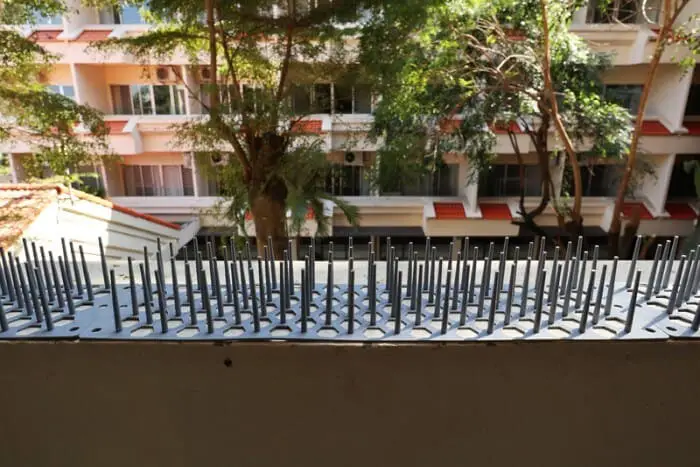
The most important thing to do when you decide to try and catch pigeons near your property is to have a plan in mind for when you catch them.
Simply releasing them isn’t going to solve the overall problem so contact experts in your area who can take the birds off your hands once they’ve been captured.
